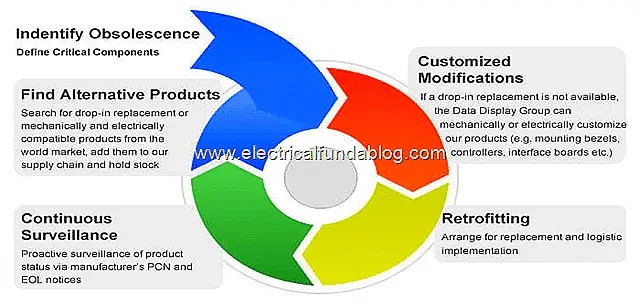An Obsolescence Management Process has various advantages if it is effective integrated to various stages of a product with an objective to tackle Obsolescence. With the increasing popularity and functionality of Commercial components in comparison to cost, the component obsolescence has been much frequent. Only an effective Obsolescence Management can minimize financial losses and ensure maximum product availability.
Obsolescence Management and its Objective
A co-ordinated set of actions and activities of an organization to tackle/ control the obsolescence threat is known as Obsolescence Management.
The objective of Obsolescence Management is to ensure that obsolescence is managed through out the defined useful life of a product by integrating an Obsolescence Management plan from as early as the product’s design and development phase, continues through production and exploitation phase and till the product’s defined life such that its financial and availability impact can be minimized throughout the product lifecycle.
Advantage of Having an Effective Obsolescence Management
An effective Obsolescence Management maintains the optimum balance of operational availability and cost of ownership by:-
- Minimizing the unacceptable loss of operational availability that arises from expensive redesign, replacement and lengthy down times through unavailability of obsolete items.
- Minimizing unplanned expenditure by maximizing the time and the Obsolescence mitigation options available by proactively planning for obsolescence.
- Avoiding multiple independent efforts to resolve the same or similar obsolescence problems resulting in unnecessary cost.
 Obsolescence Management Process at Various Product Life Stages
Obsolescence Management Process at Various Product Life Stages
As said above, Obsolescence Management is a continuous process that ideally begins right from the design stage and continues through production and exploitation till the product’s defined life.
1. Concept Stage Obsolescence Management
When a system design is conceptualized, the organization formulates its functional/ technical requirements of the product. During this phase, Obsolescence Management must be clearly defined as a key activity in the functional/ technical requirements.
Obsolescence Management involves spare consumption and so it must be considered as a time, resource and cost consuming activity. Failing to include it in early stage may affect its inclusion later on view various factors involved in it. This should be the first task under Obsolescence Management Process.
2. Contract Stage Obsolescence Management
This is the stage where proactive approach is first adopted to tackle obsolescence issues in future. If you want to implement a good Obsolescence Management strategy, it is very necessary to clearly define your contractual conditions for Obsolescence Management such that these contractual conditions must lay the requirement for necessary planning, analysis, mitigation and resolution options for supporting the product throughout its contracted life.
Based on these contractual conditions, a Through Life Management Plan (TLMP) must be made that should include detailed component and product level Risk Assessments.
3. Design Stage Obsolescence Management
Post conceptualization of a system’s requirement, it is very necessary to formulize the Equipment Tree Structure or the System Structure Breakdown at the preset of Design Stage. In System Structure Breakdown, the system is further split into sub system, sub-sub-system, sub-sub-……-sub system till the contracted level of interest.
Normally, contracted level of interest for an organization is LRU (Line/ Least Replaceable Unit). An LRU can be component or PCB or even a sub-system as required by the organization. Scaling of spares is required to be carried out at this LRU level ideally.
Post Finalization of the Equipment Tree Structure or the System Structure Breakdown, the next step should be to carry out the Part Selection. Part Selection is the process to select suitable components for the finalized design of the product.
A cautious approach should be made in selecting the components in order to achieve the contact defined product life, functionality, tolerance (De-rating) and Reliability standards under user specified environment and stresses. There should always be a balance between cost and quality of the component. If you cut the cost and select lower grade components, you will have to sacrifice the functionality and tolerance of the system. Similarly, if you select higher grade components than required, you will end up losing profit.
Part Selection for any project depends on the various factors such as:-
- Available and desired electrical characteristics of component
- Desired Function of product w.r.t. component
- Environmental conditions
- Desired Dimensions (Size, weight, shape etc)
- Reliability
- Quality
- Tolerance and Stresses (De-rating)
- Life of component Vs required product life (Obsolescence)
- Standardization
- Ruggedization
4. Production Stage Obsolescence Management
Availability of components finalized needs to be checked in this stage. The Production agency should ensure that the involved component’s support is available for the required product life. A risk assessment shall be carried out to determine the risk to the component as well as entire product from obsolescence. Based on the Risk Assessment, suitable approach (Proactive or Reactive) may be applied to mitigate the incoming/ affecting obsolescence.
5. Exploitation Stage Obsolescence Management
Risk Assessment for the component/ product must be undertaken in regular intervals of time. The time interval between the Risk Assessments may be decided as convenient, preferably between 2-5 years. Based on the Risk Assessment, suitable approach (Proactive or Reactive) may be applied to mitigate the incoming/ affecting obsolescence.





